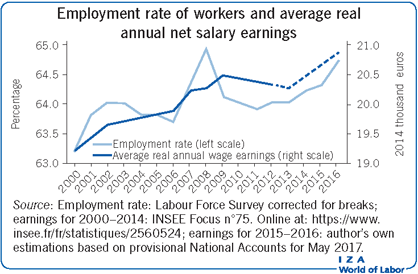Elevator pitch
France has the second largest population in the EU. Since 2000, the French labor market has undergone substantial changes resulting from striking trends, some of which were catalyzed by the Great Recession. The most interesting of these have been the massive improvement in the education of the labor force (especially of women), the resilience of employment during the Great Recession (albeit with a very late recovery), and the dramatic emergence of very short-term employment contracts and low-income independent contractors, which together fueled earnings inequality.

Key findings
Pros
The proportion of tertiary-educated workers is continuously increasing, while their employment rate remains high and acyclic.
The Great Recession did not stop the rise of the employment rate for women, now at its highest level since World War II.
The labor force participation rate of workers aged 50–64 has risen.
Real earnings of the average and median full-time worker have risen.
While remaining somewhat lower, women’s wages have slowly improved relative to men’s.
Cons
Long-term unemployment is far above its pre-Great Recession level; older workers’ unemployment has also risen.
Spatial heterogeneity in unemployment has widened.
The use of very short-term labor contracts (less than a week) has increased dramatically.
Annual salary earnings inequality has increased and is concentrated in the bottom of the distribution.
Traditional artisans are being replaced by new independent contractors with low incomes.